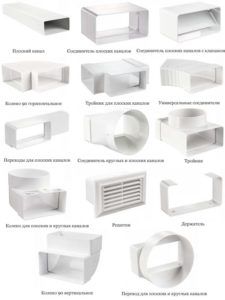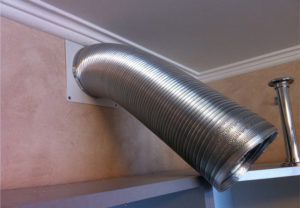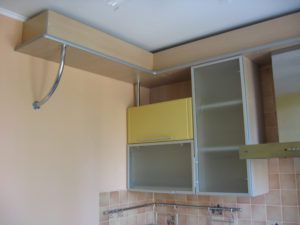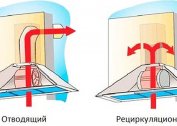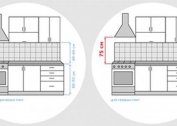Hood in the kitchen is very important. The ventilation system provides the exhaust air to the outside or its purification using special filters. For the entire system to work properly and in full force, it is necessary to pay attention not only to the choice of the hood itself, but also to mount the pipeline in accordance with the rules.
The main characteristics of the duct and its location
The exhaust hood selected depends on which hood is selected. The ventilation system can have access to the street or not. If the hood involves the exit of air into the street, it is necessary to install a pipe for the hood in the kitchen.
When planning the arrangement of furniture, it is worth considering some rules for the location of the stove. This will be directly related to the device of the pipe for the hood in the kitchen. First of all, it is important to remember that the stove should not be placed against the wall of the opposite ventilation shaft. This is because the exhaust pipe will be too long.
Every extra meter of ventilation duct reduces system performance by 10%.
To date, the pipe for the hood in the kitchen can be made of various materials. However, they can be plastic or corrugated. Each exhaust pipe has certain features that you should be aware of before purchasing all components.
Characteristics of plastic pipes for hoods
Plastic or PVC pipes can be square or round in cross section. Pipes for hoods with a circular cross section are distinguished by the least resistance the poet is more popular. At the same time, it is much easier to work with square products, in addition, they look much more aesthetically pleasing. Such exhaust pipes for the kitchen can easily be placed near the wall.
When arranging a ventilation system with plastic pipes, special attention should be paid to the joints. All joints should be well insulated, this will prevent the penetration of exhaust air into the premises. And also the air masses without obstacles will pass through the channel and exit on the roof or in another place where the ventilation shaft is removed. To connect the elements can be used special adapters.
In order to select all sizes correctly, all components are best purchased at the same time.
Flat plastic pipes for the hood have a number of indisputable advantages that stand out from other materials. During the operation of the hood and the passage of air masses, no noise is generated. The whole system is quiet enough. The perfectly flat surface of the PVC products does not create any resistance during the passage of air. Pipes for kitchen hoods of a plastic type, unlike corrugations, do not become clogged with garbage and do not accumulate fatty deposits on the surface.
Features of using corrugated pipes
Today, a pipe under the hood from the corrugation is also found in kitchens. This metal product has a circular cross section. That is why when buying such a pipe, you should immediately purchase an adapter that will allow you to connect to a rectangular ventilation shaft. The corrugation is very easy to install, and all work can be completed in a few hours.In order to fix the exhaust pipe, it is necessary to use special clamps that are pulled together by bolts.
The advantages of a corrugated-type exhaust pipe include several points. First of all, the ability of a kitchen exhaust pipe of this type to stretch by a significant amount. The use of such a pipe makes it possible to minimize the number of sharp bends, which will not affect the performance of the entire system. The cost of corrugations is several times lower than plastic options and PVC products, which is very much appreciated by customers. An exhaust pipe of this type can be used with a larger diameter than the opening of the ventilation duct that leads to the roof. In this case, it is worth choosing the adapter dimensions correctly.
How to choose the diameter of the exhaust pipe
When choosing pipes for the exhaust system, it is worth paying attention not only to the material from which they are made, but also to the dimensions.
The diameter of the hood should not be less than the outlet of the ventilation shaft, which leads to the roof.
If you purchase a pipe of a smaller diameter, then the performance of the entire exhaust system will decrease significantly, since there will be additional resistance and air will be much worse out. The most correct if the diameter of the duct pipe and the opening of the ventilation shaft are the same.
In addition to the diameter of the pipe, it is very important to consider the places of bends. If adapters are used, they should create an obtuse angle. When the pipe bends 90 degrees, air will also be vented out with some difficulties. In some cases, reverse thrust is also possible. In order to prevent the occurrence of such an effect, in some cases, the ventilation system is equipped with special valves. They prevent the passage of air masses back into the kitchen.
In order to carry out all the work on the ventilation duct device, it is worthwhile to prepare drawings for yourself first. They need to note all the places of bends and calculate the possible loss of performance.
Each 90 degree bend reduces system performance by 10%.
Options for hiding the ventilation pipe
In order for air to be vented onto the roof from the premises through the ventilation system, it is worthwhile to make a channel device from the exhaust to the ventilation shaft opening. For this purpose, pipes of various types can be used - plastic or corrugated. Regardless of the type, the end result is a rather massive design that does not always fit harmoniously into the overall kitchen interior.
To solve such a problem today is quite simple. You can use various options for this. The most common is the use of a plastic box, which is designed specifically for this. Such a box can be located on any part of the wall - under the ceiling, over kitchen furniture and more. The exhaust pipe can also be hidden under drywall. To do this, it will be necessary to perform a metal profile frame, which will subsequently be sewn up with gypsum plasterboard. This method is justified if ventilation is laid at the stage of repair work. Thus, it can be hidden, and the design of drywall can be as a decorative part of the interior. Additionally, this type of box can be equipped with lighting fixtures.
Before disguising the entire ventilation system, it is mandatory to check it in operation, this will eliminate the leakage of exhaust air and other unpleasant moments. By eliminating such defects, you can safely hide the exhaust pipes in any way and not worry about the performance of the entire system as a whole.Having completed all the work correctly, you can not only provide constantly clean air in the room, but also an attractive appearance.

